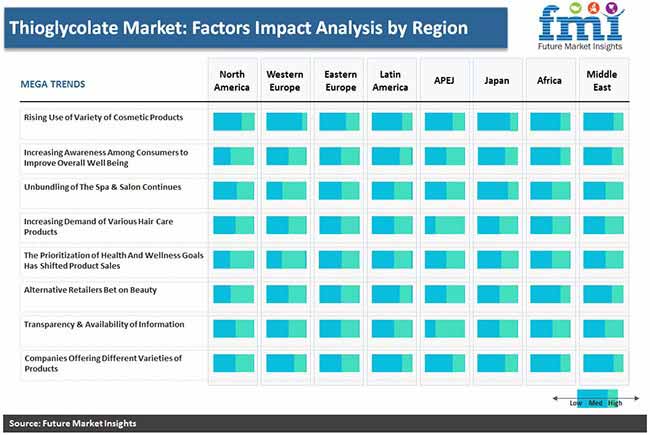Future Market Insights (FMI) delivers key insights on the global bioprocessing analytics equipment market in an upcoming report titled “Bioprocessing Analytics Equipment Market: Global Industry Analysis 2013–2021 and Opportunity Assessment 2022 – 2028”.
In terms of revenue, the global bioprocessing analytics equipment market is anticipated to register a CAGR of 4.5% over the forecast period, owing to various factors, regarding which FMI offers detailed insights and forecasts in this report.
Bioprocessing Analytics Equipment Market: Segmental Analysis
The global bioprocessing analytics equipment market is segmented based on product type, application, end user and region. Based on product type the market is segmented into osmometers and bioprocess analysers. Osmometers is the leading product type in the bioprocessing analytics equipment market over the forecast period.
North America is expected to gain popularity over the forecast period, driven by cell-based bioprocesses extensively utilised for therapeutics protein production. Manual monitoring of such bioprocesses is labour intensive and can lead to errors in the production process.
To remain ‘ahead’ of your competitors, request for a sample @ https://www.futuremarketinsights.com/reports/sample/REP-GB-5405
Due to rapid advancements in technology, manufacturers have developed integrated multi-functional analysers, which combine the functionality of different single analyzers (like cell counters, osmometers, nutrient/electrolyte/metabolite bio-profile analyzers) into one technologically enabled novel sampling system to analyse the culture medium automatically. The integration of multiple functionality allows feedback control of parameters and reduces error rates in bioprocessing.
The market is further categorised based on application into clinical and industrial applications. The industrial application segment is expected to lead in the global bioprocessing analytics equipment market during the assessment period. Demand for bioprocessing analytics equipment is anticipated to be the highest across various industries, and the industrial segment is projected to register a CAGR of 4.4% over the forecast period.
The market is further classified based on end users. End user segments include Biopharmaceutical Companies, Contract Research Organization (CROs), Contract Manufacturing Organizations (CMOs), Academics & Research Institutes, and Clinical Diagnosis.
Biopharmaceutical companies are the largest end users of bioprocessing analytics equipment while demand for bioprocessing analytics equipment is expected to be the highest in Biopharma companies – anticipated to register a growth rate of 3.9% over the forecast period.
Bioprocessing Analytics Equipment Market: Regional Forecast
This report assesses trends that are driving the growth of each market segment at the global as well as regional level, and offers potential takeaways that could prove substantially useful to manufacturers looking to enter the market. The North America market is estimated to dominate the global bioprocessing analytics equipment market, accounting for a maximum revenue share of the market by 2022 end.
The Western Europe and APECJ markets are collectively expected to account for around 39.2% of the total bioprocessing analytics equipment market share in terms of value by 2022 end. Revenue from the market in APECJ is projected to expand at a CAGR of 5.9% over the forecast period.
A key trend witnessed in the bioprocessing analytics equipment market is product innovation. Furthermore, the growing importance of developing bioprocessing analytics equipment by big players to enhance their product portfolio is trending the global bioprocessing analytics equipment market.
For critical insights, request for PDF Brochure @ https://www.futuremarketinsights.com/reports/brochure/rep-gb-5405
Why Future Market Insights?
• Comprehensive analysis on evolving purchase pattern across different geographies
• Detailed insights of market segments and sub-segments for historical as well as forecast period
• A competitive analysis of prominent players and emerging players in the keyword market
• Detailed information about the product innovation, mergers and acquisitions lined up in upcoming years
Ground breaking research and market player-centric solutions for the upcoming decade according to the present market scenario
About FMI:
Future Market Insights (FMI) is a leading provider of market intelligence and consulting services, serving clients in over 150 countries. FMI is headquartered in Dubai, the global financial capital, and has delivery centers in the U.S. and India. FMI’s latest market research reports and industry analysis help businesses navigate challenges and make critical decisions with confidence and clarity amidst breakneck competition. Our customized and syndicated market research reports deliver actionable insights that drive sustainable growth. A team of expert-led analysts at FMI continuously tracks emerging trends and events in a broad range of industries to ensure that our clients prepare for the evolving needs of their consumers.
Contact Us:
Mr. Debashish Roy
Unit No: AU-01-H Gold Tower (AU), Plot No: JLT-PH1-I3A,
Jumeirah Lakes Towers, Dubai,
United Arab Emirates
MARKET ACCESS DMCC Initiative
For Sales Enquiries: sales@futuremarketinsights.com
For Media Enquiries: press@futuremarketinsights.com
Website: https://www.futuremarketinsights.com





